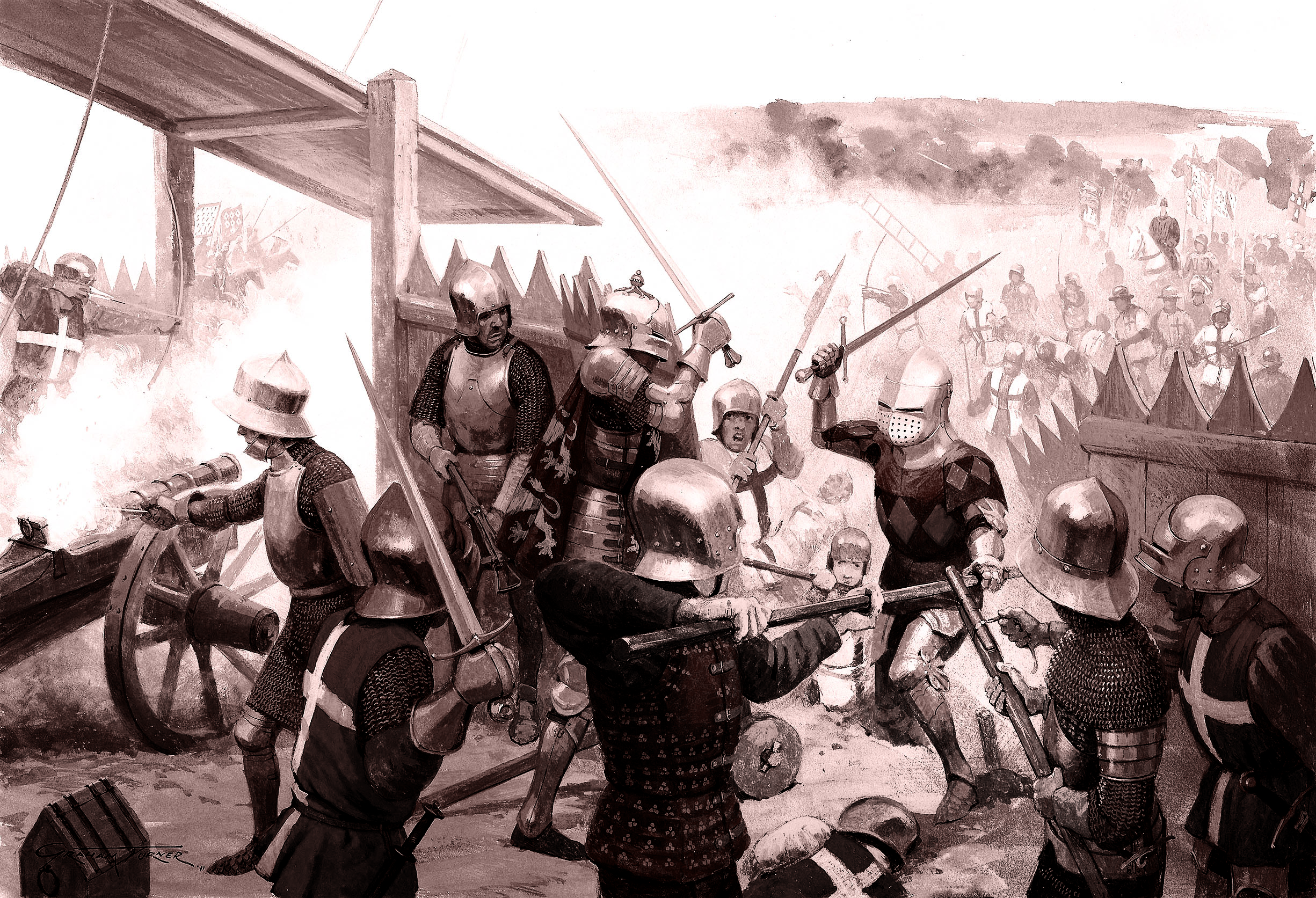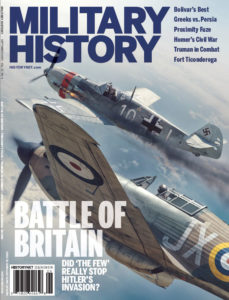The advent of gunpowder weapons in 14th century Europe prompted medieval commanders to conceive new tactics and adjust existing ones
By the mid-14th century European soldiers were confronting strange and fearsome weapons that bellowed like thunder and belched smoke and flame. Such diabolical devices heralded the arrival of gunpowder technology on the Continent some five centuries after its development in China.
Medieval commanders seeking to incorporate such weapons into their armies soon discovered it was no simple task. Given technological constraints of the period, bringing gunpowder weapons to bear on the battlefield proved far more difficult than employing them in a siege. Before the new weapons could yield results in the field, commanders had to either develop innovative tactics or adjust existing ones. The successful ones ultimately employed gunpowder weapons as part of a combined-arms approach to both inflict casualties and sap morale.
Fourteenth century European armies made use of a wider variety of tactical systems than is generally recognized. Two major trends greatly affected the tactical introduction of gunpowder weapons. The first was the rise of the professional soldier. Often described as mercenaries, these men came from the lesser noble or non-noble classes. They typically served within their own countries rather than traveling abroad to find employment. As such they were mercenaries only in the sense that they, unlike feudal levies or militia, fought for pay and were full-time soldiers.
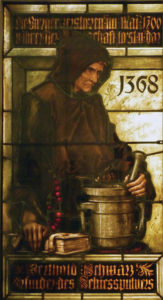
Commanders generally considered them more trustworthy and disciplined than feudal or militia levies, and they often possessed highly prized technical skills. Since they served for pay rather than for fixed periods of time, they were willing to stay in the field longer. As the 14th century progressed, the line between mercenaries and levies blurred, and the cost of waging war greatly increased. To make themselves more attractive to potential employers, professional soldiers developed specialized technical skills. Those able to operate gunpowder weapons commanded handsome salaries, thus encouraging others to develop such skills.
The 14th century also witnessed the rise, or revival, of infantry as an effective or even decisive combat arm. While infantrymen in previous centuries had occasionally proved decisive, their main function had been to screen the knightly cavalry or provide the horsemen with a place of refuge in which to regroup. If the cavalry managed to disrupt the enemy lines, the infantry might be sent forward to break up the enemy formation. Most medieval infantry forces were able to do little more, as they lacked the necessary training, discipline and equipment.
That situation changed in the 14th century as foot soldiers became more professional. Armed with both shock and missile weapons, infantrymen displayed an increasing ability to win decisive victories on the battlefield. Commanders achieved such victories by relying on a fairly uniform set of tactics with regional variations. After carefully selecting and preparing the ground on which they fought, they often deployed their soldiers in a solid defensive line. Once the battle began, the foot soldiers closed ranks to resist enemy assaults. Only when the enemy had lost momentum and become disorganized did the infantry launch an all-out counterattack. Such tactics were not particularly elaborate, nor were they always successful. Yet when employed by disciplined professional soldiers, they were quite effective.
Incorporating gunpowder weapons into such tactical systems was no easy task, given the limitations of the technology. Such weapons were severely lacking in mobility, and their rate of fire was glacially slow. Take gunpowder artillery, which was not initially mounted on wheeled carriages. To transport the heavy pieces, commanders had to have them either dragged on sledges or borne on carts. Even after armies developed purpose-built artillery carriages toward the end of the century, the weapons remained quite heavy and cumbersome.
Individual firearms of the period also proved problematic since they were unwieldy and slow to load and fire. The latter was a particularly important consideration, as aiming such weapons was difficult, and their accuracy was questionable. Tacticians and firearms designers devised various methods to compensate for the slow rate of fire, such as massing several pieces, attaching multiple barrels to the same carriage and developing breechloading weapons. But the high cost of gunpowder, lack of standardized firing procedures and challenge of creating reliable breechloaders proved difficult to overcome. Thus commanders were unlikely to rely on gunpowder weapons to fire more than a few rounds over the course of a battle.
Compensating somewhat for the slow rate of fire was the lethality of such weapons. While incapable of battering down castle walls, they were more than capable of killing or maiming armored foes. Even if it failed to penetrate armor, shot from a gunpowder weapon was likely to cause injuries or knock enemies from their feet. That stopping power was critical, as body armor grew heavier through the 14th century.
Armies recording the most effective use of gunpowder weapons during the 14th century were those assuming the tactical defensive, choosing to receive the enemy’s attack. The earliest evidence for the tactical use of gunpowder artillery on the battlefield during the period was at the Aug. 26, 1346, Battle of Crécy. After weeks on the march King Edward III of England deployed his 10,000- to 15,000-strong army atop a hill to offer battle, a challenge the larger French army of 20,000 to 30,000 men under King Philip VI could not refuse. The English deployed an unknown number of various gunpowder weapons, likely some form of early artillery.
The French opened the battle with a barrage by mercenary Genoese crossbowmen, who sought to disrupt the English formation ahead of a charge by mounted French knights. In the subsequent exchange of fire with English longbowmen, the Genoese got the worst of it. The crossbowmen also came under fire from the English gunpowder weapons. The combination proved too much for the Genoese, who hastily withdrew. Interpreting their erstwhile allies’ retreat as cowardice or treason, the French knights proceeded to massacre the fleeing Genoese. The battle then devolved into a series of rash, uncoordinated and unsupported attacks by the French knights against the strong English position, where they were cut down in droves. It is unclear how many French and Genoese casualties the English gunpowder artillery had inflicted. Perhaps only a few, as surviving chronicles barely acknowledge the presence of such weapons.
Another occasion in which an army on the tactical defensive made good use of gunpowder weapons was at the May 3, 1382, Battle of Beverhoutsveld (near Bruges in present-day Belgium). The Flemish city of Ghent had rebelled against its overlord, Louis II of Flanders, who had imposed a blockade with willing help from the citizens of Bruges, Ghent’s traditional enemy. To break the blockade, the army of Ghent—some 4,000-8,000 men under Philip van Artevelde—marched on Bruges and deployed in a defensive position on a nearby hill. Artevelde positioned several hundred ribauldequins, a form of multibarreled light artillery, on one flank to deliver enfilading fire.
The far larger combined army of Louis II marched from the city in a disorganized manner, as Bruggians had marked a religious holiday the day before, and many soldiers were either hung over or intoxicated. As Louis’ army approached, Artevelde opened a massive barrage with his ribauldequins. The unexpected fusillade caused the Bruggians to waver and then halt in confusion. A second Ghent barrage followed, as did an infantry attack that routed Louis’ forces. In the aftermath Artevelde’s army occupied Bruges, and Louis barely escaped. Again, the number of casualties inflicted by gunpowder weapons is unclear, but the effect of the Ghent ribauldequin fire on the morale of the Bruggians was undeniable. Two barrages and an infantry assault had transformed a confident advance into a panicked rout.
Despite such victories from the defensive, it proved nearly impossible to successfully employ gunpowder weapons on the tactical offensive during the 14th century.
Following Ghent’s victory at Beverhoutsveld, more Flemish towns joined it in revolt. That prompted France to side with Louis II, and in late 1382 the crown dispatched to Flanders 10,000 men under Olivier de Clisson, the constable of France. Artevelde led the 30,000- to 40,000-strong Flemish army to meet the invaders.
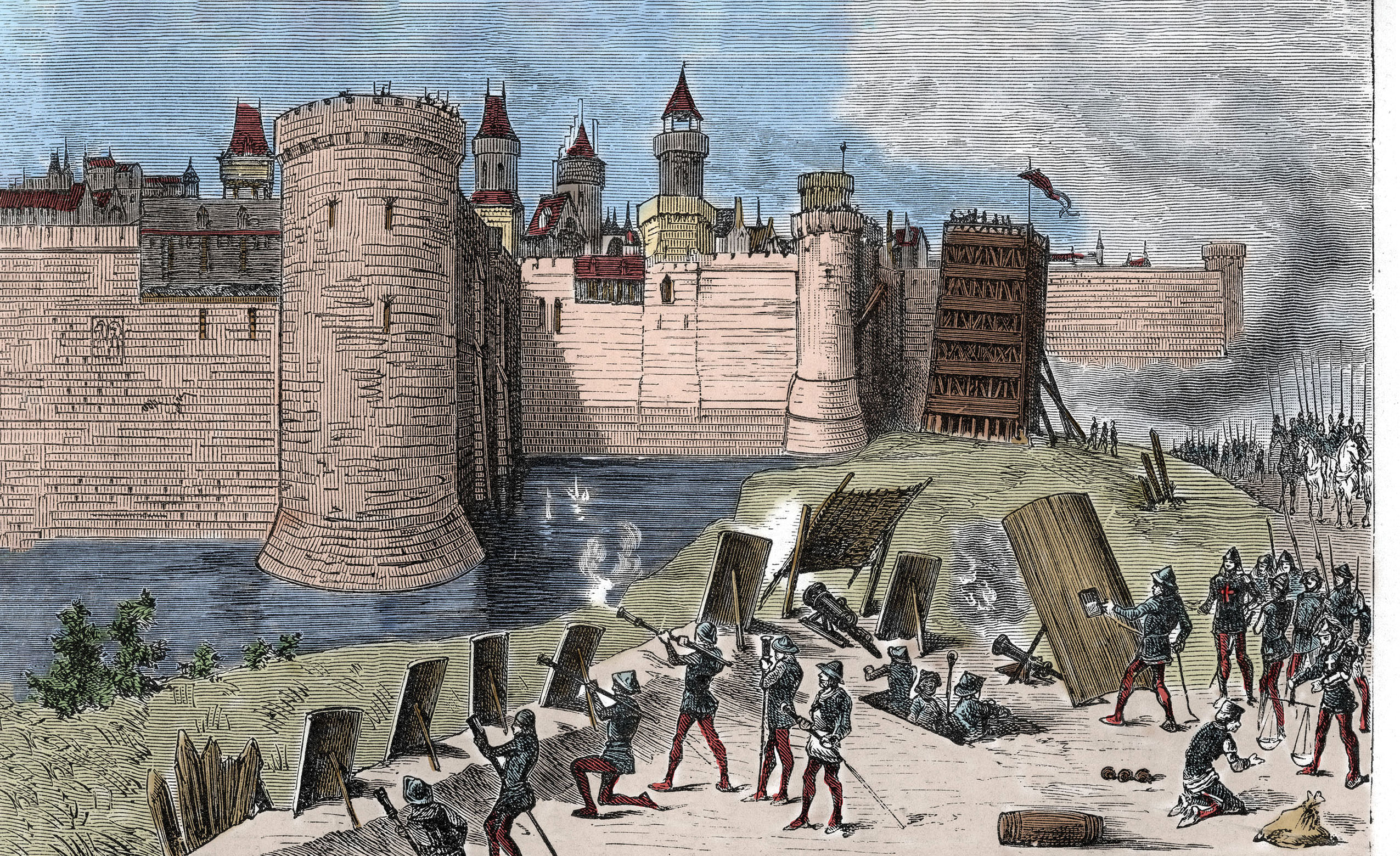
At the resulting Battle of Roosebeke that November 27 Artevelde resolved to use his previously decisive gunpowder weapons against the French, who had chosen a strong defensive position. He deployed the Flemish pikemen in a tight infantry square, with gunners and crossbowmen on the flanks. During the Flemish advance, however, those wielding the cumbersome gunpowder weapons struggled to keep up over the rough terrain. They likely only managed to fire once or twice before the advancing Flemish pikemen masked the French line. The French center initially wavered, but the Flemish formation had not engaged heavy cavalry on the enemy flanks, which were thus free to attack the exposed flanks of Artevelde’s infantry square. A well-timed French cavalry charge finally drove the Flemish crossbowmen and gunners from the field, leaving the pikemen with no hope of support. Artevelde was killed as repeated charges by the French cavalry destroyed the Flemish infantry.
Having earlier employed their gunpowder weapons so effectively to break the morale of the enemy, the Flemings had hoped for a repeat at Roosebeke. They came close, as the French center did waver, but ultimately the Flemish gunpowder weapons had neither the mobility nor the rate of fire to defend the infantry square on the attack. Their poor tactical use and deployment prevented the Flemish gunners from fulfilling their intended role, with disastrous consequences.
Gunpowder weapons were also employed offensively at the Aug. 14, 1385, Battle of Aljubarrota, which pitted the army of King John I of Castile against that of King John I of Portugal for the throne of the latter kingdom. To solidify his claim and eliminate any resistance, John of Castile launched an invasion at the head of 31,000 troops. John of Portugal received the invaders with fewer than 7,000 men, deploying his vastly outnumbered army in a hilltop redoubt fortified with interlocking trenches and caltrops. Noting the strong defensive position of the Portuguese, John of Castile subjected them to an extensive bombardment from his gunpowder weapons, while his light cavalry circled behind the Portuguese to cut off their escape.
The bombardment alarmed the Portuguese but did not dislodge them, not that they had anywhere to flee. When it became apparent the barrage was having little effect, the Castilians gunners ceased fire to conserve their dwindling gunpowder supply. They then launched a series of cavalry and infantry attacks, which also failed to make an impression on the Portuguese position. When the Castilians ultimately moved to break contact and withdraw, the Portuguese emerged to launch their own attack, driving their besiegers from the field with heavy losses.
Unfamiliar as they were with gunpowder, few soldiers of the period could have been expected to endure a protracted cannonade, even those within fixed field fortifications. The Castilian gunpowder weapons had served their intended purpose of weakening the morale of the Portuguese, but the Castilians had failed to fully integrate such weapons into their tactical system. Had the Castilians employed a combined-arms approach and not cut off potential escape routes, it is probable their bombardment would have succeeded in dislodging the Portuguese.
The 14th century also saw the first use of individual firearms on the battlefields of medieval Europe. Contemporaneous artworks depict firearm-bearing soldiers marching beside and among bowmen and crossbowmen in something of a mixed formation.
Such a formation allowed the strengths of one weapon system to compensate for the weakness of another. While the bow and crossbow had a greater range and rate of fire than any 14th century firearm, the latter had greater stopping power. In a fight bowmen in the formation would batter the enemy at long range. Gunners would then employ their firearms to either prevent the enemy from closing or at least stagger them enough to allow their own compatriots to withdraw in order.
The poor accuracy of 14th century firearms did not necessarily reduce their effectiveness. Soldiers fought in tight-knit, slow-moving masses, thus a firearm triggered in the enemy’s general direction stood a good chance of hitting a target. To a degree such weapons were capable of penetrating armor, while soldiers and horses were unused to the intimidating sight, sound and smell of firearms. Mass volleys sapped morale, often disrupting an enemy’s advance and preventing them from closing. That said, technological constraints prevented firearms from assuming an effective offensive role on the battlefield. Like their larger cousins, individual firearms lacked the mobility and rate of fire necessary to break up enemy formations or drive enemy soldiers from defensive positions.
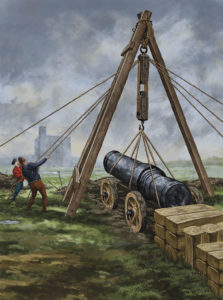
Ultimately, 14th century European armies integrated gunpowder weapons into their defensive tactical systems in a manner conforming to the tactical trends of the period. By remaining on the tactical defensive, one had less need to redeploy such cumbersome weapons, either to maintain contact with friendly troops or to adjust to new enemy attacks. Friendly infantry protected the gunners, allowing them to do their work unmolested by the enemy. That in turn enabled the gunners to reload and fire their weapons more frequently. The more volleys they fired, the more casualties they could inflict.
As fundamental to victory as it was to inflict casualties, however, gunpowder weapons also proved effective for breaking the morale of an attacking force, an often overlooked aspect of medieval warfare. Faced with the sound and fury of such weapons, some troops froze in their tracks, others fled and almost all wavered. In doing so, the attackers lost cohesion and momentum, further sapping their morale and exposing themselves to a counterattack.
Also key to the successful tactical use of gunpowder weapons on the medieval battlefield was the adoption of a combined-arms approach. Troops armed with gunpowder weapons were most effectively employed alongside and in support of troops armed with more traditional weapons. Ultimately it was not technology but tactics that made gunpowder weapons an effective tool on medieval battlefields and for centuries to come. MH
Robert C.L. Holmes is a historian and author specializing in the military history of the ancient and medieval worlds. For further reading he suggests Firearms: A Global History to 1700, by Kenneth Chase; Weapons and Warfare in Renaissance Europe, by Bert S. Hall; and Infantry Warfare in the Early 14th Century, by Kelly DeVries.
This article appeared in the September 2021 issue of Military History magazine. For more stories, subscribe and visit us on Facebook:

